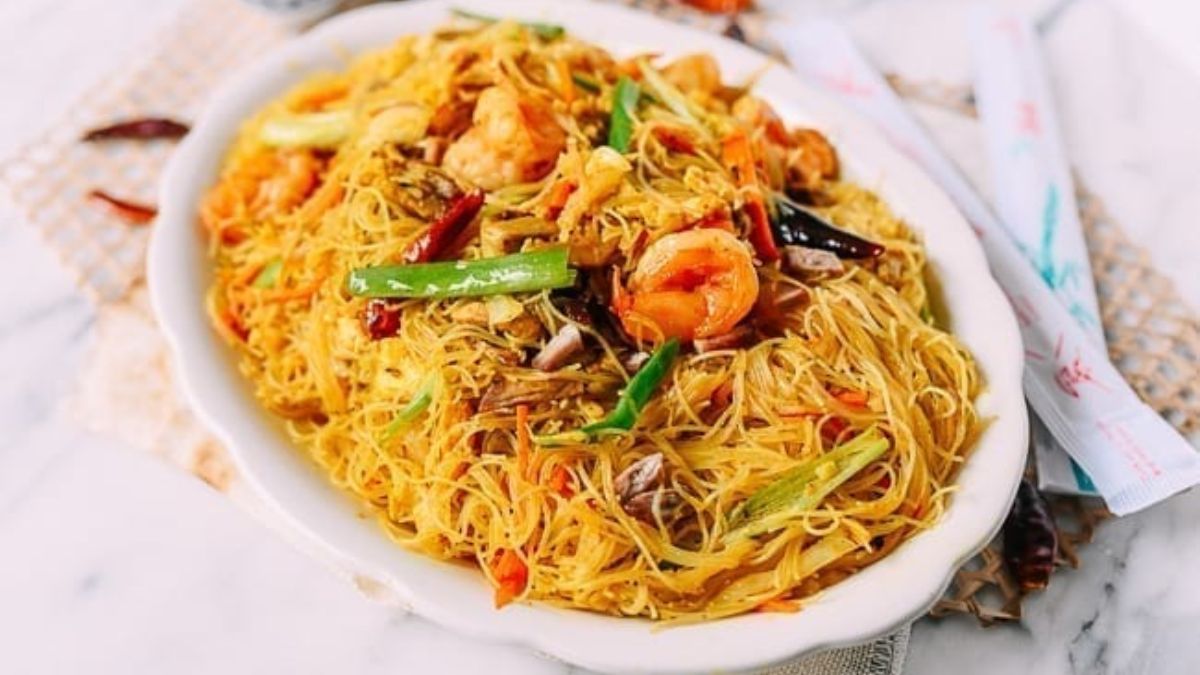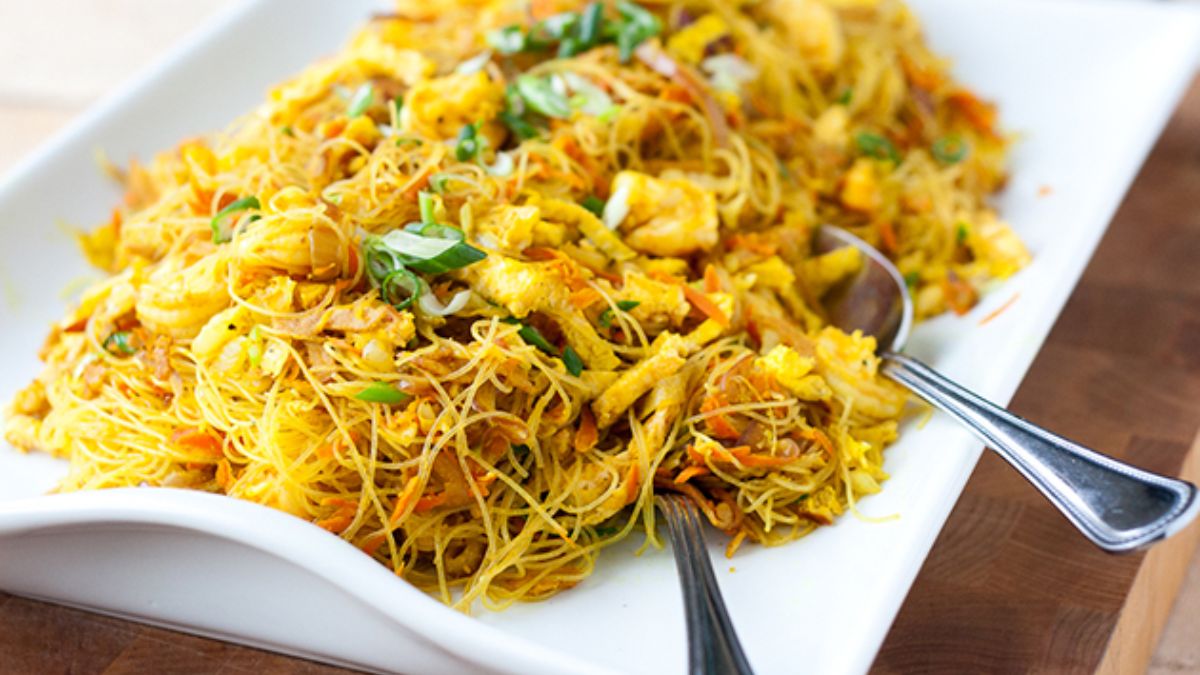Mei fun is a kind of rice-based noodle that comes from China and is eaten all over Asia. It also means dishes made with noodles, like stir-fried noodles, noodles in soup, or spring rolls. This noodle can be used in a lot of different ways. It is also called rice vermicelli and rice stick and is often mistaken for other noodles.
What is Mei Fun?
Before discussing how mei fun works, let’s discuss what fun is. We don’t mean “fun” in the English sense when we say “fun.” Instead, we mean “fun” in the sense of Chinese food. Fun is a general term that can be used to describe any rice noodle in any Chinese language that uses Chinese characters: Fresh out of the oven on a sheet, rolled out and then cut, wide, medium, narrow, or thin, all of these ways are fun.
Mei fun is especially light and airy. It is thinner than angel hair and more fragile, like vermicelli. This is why the most common English name for the ingredient is “rice vermicelli.” But some brands of mei fun will say “rice sticks” or “rice noodles” on the package. Mei fun is usually made with ground rice and water, no matter what people call it. So, it doesn’t contain gluten by nature (as long as it’s made in a facility that doesn’t use gluten). Most manufacturers use this simple, traditional recipe, but some may add egg, wheat, tapioca, beans, or other starches.
Instead of nests or straight-cut strands like pasta, the noodles are dried in long, loose bundles. They will be bright white, soft, and stick together when rehydrated. Uncooked, they are almost clear, with an opaque middle and a plasticine-like shine on the outside. If you keep them sealed, dry, and in a cool, dark place in your pantry, they will stay fresh until you are ready to use them again.
Ingredients:
- Vegetables of choice
- Meat of choice
- Vermicelli noodles
- 2 tbsp Char Sui sauce
- 1 tbsp soy sauce
- Cooking oil
- Ginger
- Garlic
- Sugar (optional)
- Curry powder (optional)
Instructions:
- Start by cutting up a lot of your favorite vegetables. Also, we suggest you try various proteins when it comes to meat. Adding beef and pork is a great idea. You can also try mixing in chicken and shrimp for a different flavor.
- Marinated meat will make a big difference in this noodle recipe. Mixing two tablespoons of Char Siu sauce, a BBQ sauce, withone1 a tablespoon of soy sauce gives beef or pork a salty cook the meat in hot oil on its own then set it aside.
- Pour hot water over the vermicelli noodles and let them sit for about two to three minutes. Please give them a light stir to open them up, drain the water, and set them aside.
- Now, brown some ginger and garlic in a wok. Add the vegetables and stir-fry them for two to three minutes. Next, put the cooked and marinated meat back into the wok and mix everything. Lastly, put the noodles in.
- You can put soy sauce, sugar, and curry powder on them.
- You want this dish to be dry but well-coated. Mix everything for about a minute over high heat, then serve them immediately.
What are the Different Kinds of Mei Fun?
Because chow mei fun is a country dish made from whatever is in the kitchen, there are many different ways to make it.
Singapore mei fun, a Cantonese dish, is the most well-known type (no one knows how it got its name, but it does not originate from Singapore). It looks and tastes different because curry powder gives it a bright yellow color and a spicy flavor. This dish usually has more than one kind of protein in it. Bell peppers, onions, carrots, bean sprouts, and scallions that have been thinly sliced and are crunchy are often added. Most of the time, you can count on shrimp, pork, eggs, and cabbage in some form.
Then, there are many different ways to make chow mei fun dishes with and without sauce. Before being stir-fried with meat and vegetables, the dark-sauced versions are tossed in a mix of soy sauces, oyster sauce, and Shaoxing wine. Salt, white pepper, monosodium glutamate, sauces like fish sauce, and a lot of oil are used to make light-colored chow mei fun that doesn’t have any sauce.
Mei Fun vs. Glass/Cellophane Noodles, Chow Fun, and Lo Mein
- The variety of noodles in Chinese food shows that the Chinese are experts at making noodles. So if you feel confused, know that you are not alone. Even people born and raised in the culture don’t always understand all the differences in translation and noodles.
- People often mistake dry rice vermicelli for glass or cellophane noodles, which is the most common mistake. Its color, or lack of color, can be almost clear, light grey, or glassine amber; white rice vermicelli turns a very bright white. They come in the same package and look very similar, from the width to the different levels of transparency. On the other hand, cellophane noodles are made from starches, usually, mung bean or sweet potato starch but sometimes rice starch. When they are cooked, they look and feel like gelatin.
- The differences between ho fun, lo mein, chow mein, and mei fun are much clearer. However, they are still hard to understand because of mistakes in translation—not just between different Chinese dialects but also between different Chinese languages—and different ideas about what the words mean in different parts of China.
Some Additional Factors
- To start with fun, ho fun means long, flat, steamed sheets of white rice noodles. When made fresh for quick Chinese-style eating, these are cut into squares for stir-frying into chow fun or just smaller sheets for rice rolls. But some countries, like Thailand, have found ways to dry them into flat, ribbon-like noodles. These noodles can be as wide as linguine, fettuccine, or pappardelle, and they can be just as thin (a little thicker than mei fun), medium (common to pad thai), broad, or XL, which are both common for pad see ew.
- Then there’s lo mein, which is made from wheat and eggs. Most of the time, they are buttery yellow, thick-walled, chewy, and soft. If you ask for lo mein on the East Coast, you’ll get this stir-fried noodle dish. On the West Coast, however, you must ask for chow mein to get lo mein. Cn the Atlantic side, chow mein is a stir-fried, saucy dish with many vegetables that are meant to be mixed with wide, flat, deep-fried soup noodles.
- Confused? Lastly, Cantonese chow mein is a dish that people on both coasts like. This is a nest made from fresh, thin egg noodles (also called wonton noodles) cut to the same size and shape as mei fun. They are pan-fried until they are crispy and then topped with a thick sauce that soaks into the crunchy nest, softening the noodles and giving them flavor at the same time.
What does Mei Fun Taste Like?
Mei fun has a neutral taste, like white rice, with a slight sweetness that fades into the background. If reconstituted correctly, it is al dente and has a thread-like bite. But if you boil it like you would pasta, it can get too soft and overcooked.
Mei Fun Recipes
Rice vermicelli is a very versatile ingredient, and the recipes that call for it are just as improvised. Even better, the noodles are gluten-free, adding to their appeal. But keep an eye out for dishes that use soy sauce, oyster sauce, or Shaoxing wine.
Here are some of the best interpretations of mei fun:
- Singapore Noodles with Rice Vermicelli
- Pho Bo Soup (Vietnamese Beef Noodle Soup)
- Bun Bo Xao (Vietnamese Noodle Salad with Lemongrass Beef)
- Thai Fresh Spring Rolls
Even though mei fun noodles come from China, they are now a part of Thai, Vietnamese, Cambodian, South Indian, Indonesian, Malaysian, Burmese, Filipino, and, coming full circle, Singaporean cuisine. They are used in soups, stir-fries, sautés, cold noodle salads, and even sweet desserts. in India
Is Mei Fun Good for you?
Since mei fun is used for so many different things, it’s hard to say if eating it is good for your health or not. It all depends on how you get ready. The noodles don’t have much nutritional value, and they have almost no fat or sodium1. Adding sauces or other seasonings to stir fry adds sodium. Adding vegetables to your chow mei fun will make the dish healthier. In Vietnamese soups like a bun, pho, and others, mei fun is a nice, light background that lets the fresh ingredients shine.
Where to Buy Mei Fun?
In most regular grocery stores’ Asian/International aisle, you can find at least one brand of rice noodles. However, the best place to find vermicelli-thin noodles is at your local Asian market, which will cost a lot less. It’s also available online.
Storage Tip
Dry mei fun noodles will last forever if kept in their original package and in a cool, dark place. The best time to use them is within three years. Once you’ve opened them, store them in a pantry bag or container that won’t let air in. You can put it in the fridge and cover it with plastic wrap when it’s done. It will stay fresh for three to five days. Please don’t put it in the fridge while it’s still hot or steaming, or the condensation will make the noodles soggy.
Conclusion
Rice noodles are used to make mei fun noodles. Before putting them in soups or stir-fries, all they need is a quick soak. This recipe calls for dried rice noodles that have already been cooked and dried. Because rice and water make traditional Mei Fun, it has a mild flavor with hints of sweetness. On the other hand, Lo Mein has a fuller flavor and soaks up sauce even better. So, you can choose one or the other based on your taste, but it’s nice to know that they’re both delicious.


